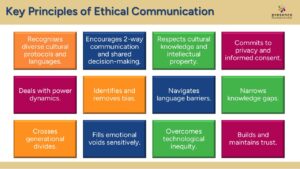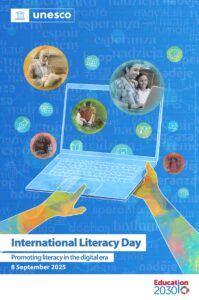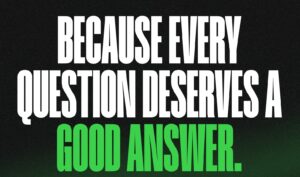Illuminate your message with a clear spotlight, not a messy floodlight
“Too little information and you’re blind, too much and you’re blinded.”
This line from Stuart Turton’s debut novel, The Seven Deaths of Evelyn Hardcastle, caught my eye.
For me – someone who designs, delivers, and deciphers messages for a living – these 11 words highlight why communication can often be ineffective.
The quest for understanding is sometimes described as seeking enlightenment: what should we do and why? But the light that illuminates our message can be too dim or too dazzling to help.
As communicators, we need to think like lighting designers to control the intensity, direction, and focus of the message. That’s how we ensure each one achieves laser-like cut through, not a limp lamp glow or stadium-level glare.
Here’s how I see it happening.
Blinded by Too Much Light
When light intensifies into an all-consuming white-out, you literally cannot make out anything in front of you.
It’s the “Stage Light Effect.” The lights illuminate the presenter (sender), but simultaneously blind them to the audience’s faces. You’re sending a powerful message, but you’re blind to whether anyone can actually see it.
It’s also a relentless daily reality emanating from inboxes. With 251,100,000 emails, 18,800,000 texts and 1,040,000 Slack messages sent in an internet minute last year (according to Statista), every message risks becoming white noise.
And the meeting that should have been a memo? You walked in seeking clarity and walked out with a cognitive migraine, incapable of focusing on the single action item. Now your attention span is completely fried.
The “Squinting Reflex” is a common response. Squinting is a physical reaction meant to filter excessive light so your focus narrows. When you’re mentally squinting at a complex report or a dense email chain, however, you might actually sacrifice the big picture.
It’s an exhausting, protective posture that, if held for too long, leads to decision paralysis. You cannot confidently discern which ideas go where and what actions to prioritise. Just as Nobel laureate Herbert A. Simon warned:
“A wealth of information creates a poverty of attention.”
Blind Because of Too Little Light
Recognise this feeling? You open an email or Teams chat but you can’t see it properly. The message detail is so sparse, so devoid of context, that you’re left fumbling to figure out the meaning and expectations. It’s frustrating. And sometimes a little scary.
Like the meeting invitation that says, “Project discussion”. Which project? What should you prepare? What’s at stake? It’s like the sender has handed you a matchbook, dropped you into a cavern, and expected you to find the treasure. Not unlike “Murder in the Dark” (which happens a lot in Turton’s plot).
According to Atlassian, knowledge workers spend roughly 23.5% of their work week (about 10 hours) searching through emails and messaging channels for key information that should have been clear upfront.
Then there’s the “Shadow of Suspicion” that lurks when you’re already feeling low. Are the details deliberately withheld? Why are you getting the edited version? Are you being set up to fail? Have you been pushed out of the illuminated circle of trust?
You can’t follow the correct path because the information offers insufficient light for navigation. And we all know that mistakes made in the dark usually look worse under harsh office lighting.
(Remember the shock when the lights came back on at the end of the high school disco? 😱)
Don’t be that sender. Be the communicator who thinks like a lighting designer, projecting the right light (context, details) to create a clear, visible path to meaning and action.
Engineering the Light
The wisdom of Turton’s phrase illuminates why it’s important to set sufficient light where needed, to highlight the necessary details without causing sensory overload. After all, when faced with blinding information, your audience can’t just slip on their sunglasses.
Just like most won’t be wearing a headlamp or have a torch handy when your words fail to shine a light where they should.
The best lighting designers don’t just turn lights on and off; they control intensity, direction, and focus to guide the audience’s eye exactly where it needs to go.
Here’s how to illuminate without blinding
1. Set the Intensity
Before your audience can process any information, they need to know why they should care. This single question acts as your dimmer switch, adjusting the brightness to match what your specific audience needs to see. State the “why” in your opening line, don’t bury it in paragraph 3.
Communication isn’t just about shedding light on information; it’s about managing the exposure.
2. Direct the Beam
Think spotlight, not floodlight. A spotlight illuminates one actor on stage. A floodlight washes everything in uniform brightness, so nothing stands out. By controlling the direction, a clear spotlight illuminates only the action item or critical insight, whereas a broad, messy floodlight wastes energy and obscures the view.
You trigger a floodlight by trying to put too much into one message. If you can’t state your message’s single purpose in 5 words or fewer, you’re floodlighting, not spotlighting.
Controlling the beam is what distinguishes the effect of blinding people from truly enlightening them.
3. Filter the Beam.
It’s risky to assume that relevance is obvious to your reader or listener. The finance team doesn’t need to know about your product roadmap, for example, unless you explicitly connect it to budget implications. Before you hit send, ask yourself: If my recipient only reads 2 sentences of this, what must those 2 sentences be? Now put those sentences at the very top.
And before you copy the whole department, ask yourself if the information is essential for everyone or just nice-to-know? What’s your true motivation for the CCs and BCCs?
4. Create Contrast.
Use the shadows of other objects to define form – bold type, bullet points and white space help to highlight and prioritise the key elements of a long or complex message. Recognise that the reader’s attention is a finite resource – communication should be designed not just to transmit facts, but to guide them to the most important elements. Make it easy on the eyes and your reader will thank you.
The difference between feeling blind and being blinded is the difference between operating in ignorance and being knocked out by knowledge. Give your audience enough light to see the path forward, but not so much they can’t open their eyes.
Stuart Turton’s protagonist learned this the hard way. The Seven Deaths of Evelyn Hardcastle is not a light read – it’s Groundhog Day and The Good Place meets Agatha Christie at Poe’s House of Usher. You might need an oil lamp.
If you’d like to become a more confident communicator, book a complimentary, unconditional Communication Coaching Clarity Call.




